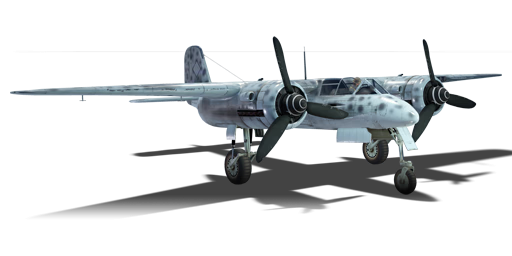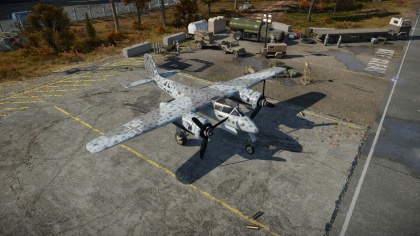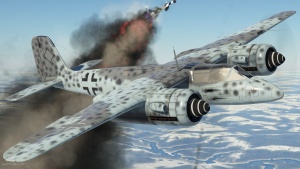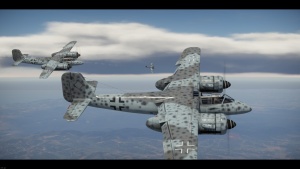Ta 154 A-1
Contents
Description
The Ta 154 A-1 is a premium rank III German twin-engine fighter
with a battle rating of 4.3 (AB/RB) and 4.0 (SB). It was introduced in Update 1.65 "Way of the Samurai". The Ta 154 A-1 is part of the revenue share program and was created by Vitaly "NovA29R" Vostokov (model) and Michael "__StrafeMike__" Ioannidis (texture).
The Ta 154 A-1 has very powerful frontal armament, placed in the fuselage, which can give you quick and easy kills. Unfortunately, it doesn't turn very well at low speeds so it is recommended to keep your speed up and Boom & Zoom. Turning should be a last resort. If you try to get an edge in a turn-fight using your flaps, you should watch your speed as your flaps can break off very easily at speeds above 450 km/h (279 mph). The roll-rate of the Ta 154 is almost as good as the Fw 190s roll-rate, this is due to the fact that there are no fuel tanks in the wings. This advantage can and should most definitely be used when flying evasively but when at low altitude, do periodically check what's in front of you.
General info
Flight Performance
Describe how the aircraft behaves in the air. Speed, manoeuvrability, acceleration and allowable loads - these are the most important characteristics of the vehicle.
| Characteristics | |||||||
|---|---|---|---|---|---|---|---|
| Stock | |||||||
| Max Speed (km/h at 6,700 m) |
Max altitude (meters) |
Turn time (seconds) |
Rate of climb (meters/second) |
Take-off run (meters) | |||
| AB | RB | AB | RB | AB | RB | ||
| 634 | 615 | 10500 | 24.3 | 25.2 | 12.77 | 12.77 | 560 |
| Upgraded | |||||||
| Max Speed (km/h at 6,700 m) |
Max altitude (meters) |
Turn time (seconds) |
Rate of climb (meters/second) |
Take-off run (meters) | |||
| AB | RB | AB | RB | AB | RB | ||
| 693 | 659 | 10500 | 21.8 | 23 | 20.5 | 16.1 | 560 |
Details
| Features | ||||
|---|---|---|---|---|
| Combat flaps | Take-off flaps | Landing flaps | Air brakes | Arrestor gear |
| ✓ | ✓ | ✓ | X | X |
| Limits | ||||
|---|---|---|---|---|
| Wing-break speed (km/h) |
Gear limit (km/h) |
Combat flaps (km/h) |
Max Static G | |
| + | - | |||
| 480 | ~8 | ~4 | ||
| Optimal velocities | |||
|---|---|---|---|
| Ailerons (km/h) |
Rudder (km/h) |
Elevators (km/h) |
Radiator (km/h) |
| < 420 | < 420 | < 460 | > 324 |
| Compressor (RB/SB) | ||
|---|---|---|
| Setting 1 | ||
| Optimal altitude | 100% Engine power | WEP Engine power |
| 1,900 m | 1,300 hp | 1,521 hp |
| Setting 2 | ||
| Optimal altitude | 100% Engine power | WEP Engine power |
| 5,500 m | 1,150 hp | 1,345 hp |
Survivability and armour
- 12 mm Steel - Front cockpit plate
- 10 mm Steel - Instrument panel plate
- 8 mm Steel - 2 x Side cockpit plates
- 10 mm Steel - Pilot's seat
- 10 mm Steel - Rear cockpit armor plate
- 38 mm Bulletproof glass
- 50 mm Bulletproof glass
Armaments
Offensive armament
The Ta 154 A-1 is armed with:
- 2 x 30 mm MK 108 cannons, fuselage-mounted (110 rpg = 220 total)
- 2 x 20 mm MG 151/20 cannons, fuselage-mounted (200 rpg = 400 total)
Usage in battles
RB
Climb with your cursor pointing at 15 degrees. If there are high altitude interceptor(Most commonly P-61 and Whirlwinds, note that they will typically have a higher altitude than you), destroy them if you can. Destroy the bombers that choose to fly high. If there aren't any remaining in the area, try using boom and zoom to destroy fighters that are likely going to be lower than you.
Manual Engine Control
| MEC elements | ||||||
|---|---|---|---|---|---|---|
| Mixer | Pitch | Radiator | Supercharger | Turbocharger | ||
| Oil | Water | Type | ||||
| Not controllable | Controllable Auto control available |
Not controllable Auto control available |
Controllable Auto control available |
Combined | Controllable 2 gears |
Not controllable |
MEC usage guide
This plane doesn't differ a lot from the Bf 109s and Fw 190s regarding usage of Manual Engine Settings.
Prop pitch: unless you really know what you're doing, don't even dare to think about using it.
Radiator: radiator can be set at 30% for a long time but will eventually have to be changed to 40-50% as the engines will start to overheat continuously. While this happens you will be forced to use WEP less as the match progresses unless you stop using MEC for quite a while or land and repair which will reset this. Radiator can be left at around 40% for winter maps, 50% for spring/fall maps, and 60% for summer maps without much issue except for prolonged usage of WEP.
Supercharger stage: For optimal performance switch to stage 2 at 4 km (13,123 feet)
Modules
| Tier | Flight performance | Survivability | Weaponry | |
|---|---|---|---|---|
| I | Fuselage repair | Radiator | Offensive 20 mm | |
| II | Compressor | Airframe | New 20 mm cannons | |
| III | Wings repair | Engine | Offensive 30 mm | |
| IV | Engine injection | Cover | New 30 mm cannons | |
Pros and cons
Pros:
- Exceptional armament (with decent ammunition count)
- Heavy armour and nose mounted 2 x 20 mm and 2 x 30 mm cannons are the perfect combo for head-on attacks
- Maneuverability is sufficient to keep up with other heavy fighters and heavier American single engine fighters
- Absurdly durable airframe and cockpit (Engines are often destroyed long before the wings or pilot are lost)
- Can operate on a single engine (enough to get back to the airfield)
- Decent climb rate
- Interceptor spawn, will gain altitude much faster than its opponents
- Exceptional speed in a straight line
- Low wing load gives the plane a good turn rate at higher speeds
- Exceptional roll rate
- Excellent bomber interceptor
- Fear factor: Many Allied pilots who would normally go head on will break off from a head-on engagement, allowing you to either extend and make another pass or shoot him down if they pulls up or rolls to dodge
- Excellent glide ratio owing to wooden construction and low wing loading
Cons:
- Flaps break off easily at speeds above 450 km/h (279 mph)
- Varying muzzle velocity of the Mk 108 and MG 151 cannons makes long range shooting difficult
- Turns horribly at low speeds
- Can fly on 1 engine but only around 300 km/h (186 mph)
- Landing gears are very sensitive and will break when landing at speeds above 240 km/h (150 mph)
- Prolonged WEP can lead to engine problems, using manual engine control is highly recommended with this aircraft
- A rather large target
- Weak suspension on landing gear, watch descent rate closely
- Tail likes to fall off during belly landings, belly land only as a last resort
- Easy to over G at high speeds due to wooden construction
- Sensitive engines, will overheat quickly if radiators are punctured
- Occasionally can be pilot sniped in a head-on or by gunners through the thin plate behind the nose
- Elevator compression becomes severe past 660 km/h (410 mph), requiring a lot of room to pull out of a steep, high speed dive to avoid crashing into the ground
History
The Ta-154 was a fast twin-engine German interceptor/night fighter created and developed by renowned aircraft designer Kurt Tank during World War 2. It was eventually cancelled as it was to complicated to build for war-torn Nazi Germany.The origins of the Ta-154 dated back to the late 1930s when Kurt Tank and his engineers were working on a twin-engined medium bomber called the Ta-211. It was planned to be made out of plywood bonded with a special chemical called Tego film. Only the pressurized cockpit would be made out of metal. The aircraft was supposed to use the Jumo 211r engine (which was why the Ta-211 had the number 211) but was instead fitted with the more powerful Jumo 213 engine when Junkers could not produce the Jumo 211r in time. The aircraft's serial number was changed to 8-154 and it was given the name Moskito as a tribute to the RAF's Dh.98 Mosquito.
The Ta-154V1 prototype made its first flight on July 1st, 1943 with the Jumo 211F engine. A few days later, the V2 prototype with the Jumo 211N took off for the first time. In trials, the Ta-154 easily outperformed its rivals- Ju-388 and He-219. The Ta-154 reached at top speed of 700km/h or 440mph in testing. The V3 prototype was equipped with radar and a second seat for the radar operator and was consequently 75km/h slower than the other two prototypes with its heavy night fighting equipment. Nevertheless, it still had superior performance to the He-219.
In early 1944, the Jumo 213 engines finally arrived and a production run of 150 plus Ta-154A-1 models were ordered. Several were produced before the factory making the Tego-film glue was destroyed. As a result, the Germans substituted the Tego-film glue with an inferior type of glue. This inferior type proved to be complete garbage as several Ta-154s created with it fell apart in flight. Similar problems also beseeched the He-162 Volksjager.
In August of 1944, Kurt Tank finally ordered the end of production of what could have been an amazing fighter as the Germans needed to turn their attention to faster aircraft like the Do-335 and could not waste time or resources. With that, the few Ta-154s built were used in night fighters squadrons or in training units. Several Ta-154s out of the 50 or so built saw combat in World War 2 as night fighters until the war ended. With that, the Ta-154s were examined or scrapped. One was captured by American forces but its fate is unknown.
Even though the Ta-154 only had a minor impact in real life, you can take control of the mighty Ta-154 in War Thunder and wreak havoc on the bombers that escaped its wrath back in WW2.
Media
See also
Links to the articles on the War Thunder Wiki that you think will be useful for the reader, for example:
- reference to the series of the aircraft;
- links to approximate analogues of other nations and research trees.
External links
Paste links to sources and external resources, such as:
- topic on the official game forum;
- encyclopedia page on the aircraft;
- other literature.
/references
| Focke-Wulf Aircraft Corporation (Focke-Wulf Flugzeugbau Aktiengesellschaft) | |
|---|---|
| Fighters | Fw 190 A-1 · Fw 190 A-4 · Fw 190 A-5 · Fw 190 A-5/U2 · Fw 190 A-5/U12 · Fw 190 A-5/U14 · Fw 190 A-8 |
| Fw 190 C | |
| Fw 190 D-9 · Fw 190 D-12 · Fw 190 D-13 | |
| Fw 190 F-8 | |
| Ta 152 C-3* · Ta 152 H-1* · Ta 154 A-1* | |
| Bombers | Fw 189 A-1 · Fw 200 C-1 |
| Export | ▅Fw 190 A-5 |
| Captured | ▃Fw 190 A-8 · ▂Fw 190 D-9 |
| * In 1944, the Germany Air Ministry changed new fighter aircraft designation to that of the chief designer. Kurt Tank was the chief designer at Focke-Wulf and later aircraft he designed were given the prefix of Ta. | |
| Germany twin-engine fighters | |
|---|---|
| Messerschmitt | Bf 109 Z-1 |
| Me 410 A-1/U2 · Me 410 B-1/U2 | |
| Dornier | Do 17 Z-7 · Do 217 J-1 · Do 217 J-2 · Do 217 N-1 · Do 217 N-2 |
| Focke-Wulf | Ta 154 A-1 |
| Junkers | Ju 88 C-6 · Ju 388 J |
| Germany premium aircraft | |
|---|---|
| Fighters | He 51 B-2/H · BV 155 B-1 |
| He 112 | He 112 B-1/U2 · He 112 B-2/U2 |
| Bf 109 | Flegel's Bf 109 A · Bf 109 E-7/U2 · Bf 109 G-2 |
| Fw 190 | Fw 190 A-5/U14 · Fw 190 C · Fw 190 D-13 |
| Captured | ▀Marcolin's C.R.42 CN · ▀Hawk H-75A-2 · ▀Yak-1B · ▀La-5FN · ▀P-47D-16-RE · ▀P-47D · ▀Tempest Mk V |
| Twin-engine fighters | Bf 109 Z-1 · Ju 388 J · Ta 154 A-1 |
| Jet fighters | ◄Sea Hawk Mk.100 · ◄G.91 R/4 · FFA P-16 · ◄MiG-21 SPS-K · ◊MiG-21 "Lazur-M" |
| Strike aircraft | Hs 129 B-2 (Romania) · ▀IL-2 (1942) · Bf 110 C-6 · Do 335 B-2 · He 219 A-7 · ◄Tornado IDS WTD61 · ◄Su-22M4 WTD61 |
| Bombers | Ar 196 A-3 · BV 238 · Fw 189 A-1 · He 177 A-3 · Ju 87 R-2 Libya · Ju 288 C · ▀Wellington Mk Ic |







